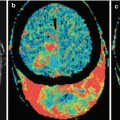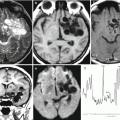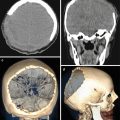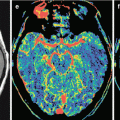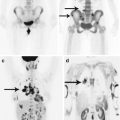, Valery Kornienko2 and Igor Pronin2
(1)
N.N. Blockhin Russian Cancer Research Center, Moscow, Russia
(2)
N.N. Burdenko National Scientific and Practical Center for Neurosurgery, Moscow, Russia
Before the advent of instrumental methods, including radiation ones, diagnosis of metastases, as well as of other intracranial tumors, was based on clinical symptoms. Neurological symptoms in metastatic brain lesions, as in case of primary tumors, are diverse and, above all, are determined by the lesion site, their number, size, and presence of perifocal edema, indicating a vascular barrier breach in the tumor tissue. Majority of cerebral metastases are located in the cerebral hemispheres (80%), cerebellar hemispheres (up to 17%), and brainstem (3%) (Tikhtman and Patchell 1995). According to Delattre et al. (1988), among the various areas of the cerebral hemispheres, the largest part of the metastatic lesions is accounted for the frontal (21%), parietal (19%), and temporoparietal-occipital (19%) lobes rather than for the temporal and occipital lobes. Typical focal symptoms (paresis, hemianopsia, aphasia, impaired hearing, vision, etc.) accompany the developing overall clinical picture with intense headache, often with nausea, vomiting, and impaired consciousness and later with increased intracranial pressure (Table 3.1).
General symptoms | % | Focal | % |
|---|---|---|---|
Headache | 49 | Hemiparesis | 59 |
Mental disorders | 32 | Cognitive disorders | 58 |
Weakness | 30 | Sensory disturbances | 21 |
Ataxia | 21 | Congested optic disk | 20 |
Seizures | 18 | Ataxia | 19 |
Speech disorders | 12 | Movement disorders | 18 |
An acute or subacute onset with progressive cerebral symptoms is characteristic of the presence of metastatic brain lesions. Thus, according to Hochberg and Pruitt (1980), metastatic tumors at the area of a transition of gray matter into the white matter—the area most frequently affected by metastases—are mostly characterized by occurrence of acute symptoms that manifest for a few days or weeks, as compared with primary tumors with the same location.
Focal symptoms primarily caused by compression of the adjacent brain regions by the metastatic lesion become pronounced and increase with the tumor growth, development of edema/swelling of the brain tissue, and displacement of nearby structures. Often, the clinical picture is aggravated by the development of ischemia due to vascular occlusion with a metastatic embolus. However, the developing local symptoms are milder than those with primary malignant brain tumors.
The principal symptom of a brain tumor lesion is progressive headache. Early headache in brain metastases is usually acute and localized and is often accompanied by nausea and vomiting. As compared to primary tumors, headaches are more intense, which may result from the development of early toxicity effects on the brain tissue and its membranes (Romodanov et al. 1973).
Early symptoms of brain metastases also include pronounced mental disorders (impaired consciousness, cognitive decline), occurring in 64–95% of cases, which, according to some authors, is more characteristic of metastatic brain lesions (Babchin et al. 1974a, b; Abasheev-Konstantinovsky 1973; Levine et al. 1978; Passik and Ricketts 1998). Thus, according to Finegold (1977), headaches, vomiting, stagnant nipples optic nerves, slow heart rate, dizziness, and general seizures occur much more frequently in primary intracerebral tumors, while mental disorders are more common in metastatic tumors. According to Kalkun (1963), mental disorders manifest as asthenia, lethargy, apathy, sleepiness, slow associative processes, memory impairment in 82% of cases. Confusion is noted in 65% of cases (Mehta et al. 2003). The development of a delirious state in function of the duration and severity of the process, according to Lawlor et al. (2000), is observed in 10–70% of cases.
One of the main focal symptoms is motor insufficiency, rarely (34%) Jackson’s seizures (Kalkun 1963). Thus, in subcortical metastases, focal manifestations occur as motor and sensory disorders and may have remitting intensity. Local and generalized seizures may occur in 40% of patients, while being the first manifestation of metastases in 10% of patients (Steblov and Mandelbeym 1962; Smirnov 1962; Ragayshene 1985; Kristijansen 1989; Flowers and Levin 1993; Emami and Graham 1997; Nakagawa et al. 1997; Helfre and Pierga 1999). It was noted that convulsive disorder is more common in metastatic renal cell carcinoma and melanoma that are radioresistant tumors. Gaidar et al. (2005) attribute this to their predisposition to hemorrhage.
Meningeal symptoms are more common with metastatic lesions in the occipital lobe and cerebellum (Christiaans et al. 2002; Kaal et al. 2005a, b). A symptom such as “stagnant nipples optic nerves” develops at later stages of the disease with progression of intracranial hypertension (Babchin et al. 1974a, b; Likhterman 1979; Kurennaya 1986; Soffietti et al. 2002; Davey 2002).
According to Steblov and Mandelbeym (1962), autopsies of patients who died of tumors with brain metastases always identified clear signs of increased intracranial pressure: meningeal tension. During the lifetime, this manifested as obvious meningeal symptoms resembling those in meningitis, smoothness of sulci, flattening of gyri, venous congestion, edema, and swelling of the brain substance, occasionally an expansion of the brain ventricles.
Cases with small lesions located in the cortical parts of the frontal and parietal regions are clinically less significant. However, the most expressed clinical picture is observed in brainstem lesions.
Lesions in the meninges may involve cranial nerves with corresponding symptoms. Secondary malignancies with the characteristic involvement of meninges include melanoma , lung adenocarcinoma, breast adenocarcinoma, and gastrointestinal tract adenocarcinoma. It should be noted that meningeal symptoms are detected more frequently in brain metastases than in primary tumors (42% and 19%, respectively). The clinical picture of a metastatic lesion in the dura mater and the skull bones is distinguished by basal (due to the presence of metastases in the dura mater of the basal parts of the brain) and convexital (due to the localization of metastases in the dura mater covering the convex surface of the cerebral hemispheres) syndromes (Krasovsky 1958).
Metastasizing into the sellar structures completely mimics the clinic picture of pituitary adenoma with signs of weight loss and hypopituitarism (Kovacs 1973). This has been noted to be much more common in breast cancer (Cairncross et al. 1980; Hirsch et al. 1982; Marin et al. 1992). Due to the blood supply specifics of the sellar structures, the neurohypophysis is initially affected.
Involvement of the temporal bone manifests by the damage to the branches of the facial nerve or impaired hearing.
Metastasizing into the pineal region rarely occurs, with the involvement of the pineal gland (1.5–3.8% of all metastases) and other deep structures, manifests as a severe intracranial hypertension syndrome, and is often accompanied by hydrocephalus (Ortega et al. 1951; Chason et al. 1963; Kashiwagi et al. 1989; Schuster et al. 1998). Local symptoms caused by the tumor compression of the midbrain structures can manifest as oculomotor disorders and other syndromes due to selective involvement of deep structures (Konovalov and Pitskhelauri 2004).
Small metastases are characterized by asymptomatic course, which is also possible if meninges are involved (Kalkun 1963; Laigle-Donadey et al. 2005; Gavrilovic and Posner 2005). It was noted that clinical manifestations of lung cancer metastases in the brain can be less pronounced. According to Snee and Rodger (1985), autopsies detected metastases in the brain in 44%, with the third of patients not being clinically diagnosed during their lifetime. Most often the frequency of MTS detection in the brain is underestimated due to asymptomatic course, with up to a third of all cases of metastatic brain lesions being diagnosed only at autopsy after patient’s death (Posner 1977).
Stay updated, free articles. Join our Telegram channel

Full access? Get Clinical Tree



